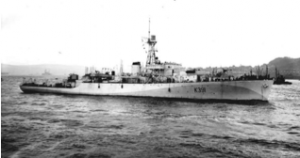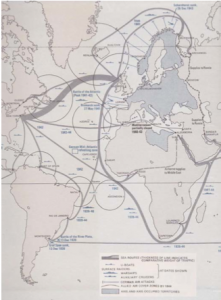Australian Sailors in the Battle of the Atlantic
Battles might be won or lost, enterprises might succeed or miscarry, territories might be gained or quitted, but dominating all our power to carry on the war, or even keep ourselves alive, lay our mastery of the ocean routes and the free approach and entry to our ports.[1]
The Battle of the Atlantic is one of the most well known campaigns of World War II. Yet, it does not refer to a single battle, engagement or action. Instead, it refers to the long struggle between Allied and Axis forces for control of the sea lanes criss-crossing the Atlantic Ocean. The Atlantic provided Great Britain with a lifeline without which it could have been starved or strangled into submission. Without the ongoing and ultimately successful battle for sea control, supplies, equipment and troops could not have been carried from North America to Europe. Nor would it have been possible to win the war in the Mediterranean or conduct the amphibious landings that eventually drove the Germans out of Western Europe. It is not overstating the case to say that losing the Battle of the Atlantic meant losing the war.[2]
The Battle of the Atlantic began on 3 September 1939 when the German submarine U-30 torpedoed the British passenger liner SS Athenia, en route from Glasgow to Montreal, some 400kms off the Irish coast. The attack offered a precursor as to how the battle would be fought. Despite the German surface fleet boasting imposing battleships such as Scharnhorst, Gneisenau, Bismarck and Tirpitz, it was the U-boats that would prove to be the greatest threat. By the end of September 1939, U-boats had already sunk 137,084 tons of British shipping.[3]
Convoys became vital to the safe passage of shipping, and a number of RAN vessels served in the Atlantic on escort duties. The heavy cruiser HMAS Australia began convoy escort operations off the west coast of South Africa in May 1940 and remained in the Atlantic until February 1941; operating as far south as the Cape of Good Hope and as far north as Bear Island inside the Arctic Circle. She was also involved in Operation MENACE, the unsuccessful attempt to install Charles de Gaulle and a Free French Government at Dakar in September 1940, which met with determined resistance from Vichy French forces.
Five new N Class destroyers, HMA Ships Norman, Napier, Nepal, Nestor and Nizam, commissioned in Britain between November 1940 and May 1942. All served in the Atlantic on escort duties before moving on to other theatres. Nestor took part in the hunt for Bismarck in May 1941 and later that year sank U-127 off Cape St Vincent.
Also involved in the Bismarck action were four young Australians serving in the British battlecruiser, HMS Hood: Ordinary Seamen David Hall, George Hall (no relation), John Shannon and Ian Startup. All had joined the RANVR via the Dominion Yachtsman Scheme, an avenue which led many Australians to the Royal Navy. In the early hours of 24 May Hood engaged Bismarck in the Denmark Strait and after a battle lasting less than ten minutes Hood suffered a catastrophic magazine explosion, caused by German shellfire, and broke in two. Of her crew of 1418, only three survived. All four Australians perished.
The RAN’s anti-submarine school, HMAS Rushcutter, was commissioned on 13 February 1939 and by September some 62 officers and 32 sailors had completed their training. However, with a paucity of ASDIC-fitted vessels in the RAN, and with the Royal Navy in dire need of officers and sailors trained in anti-submarine warfare (ASW), these men soon found themselves on loan. By the end of 1943, some 1119 RAN officers and ratings were serving in British ships.[4] Indeed, one calculation estimated that 20 per cent of ASW men involved in the Battle of the Atlantic were trained at Rushcutter.[5]
A few of the more experienced officers were soon given their own commands in trawlers converted specifically for ASW. One of these officers, Lieutenant Commander Arthur Callaway, RANVR, took command of HMS Lady Shirley, in March 1941. Among his crew was Lieutenant Ian Boucaut, RANVR, another who had joined the navy under the Yachtsman Scheme. Lady Shirley became the first British vessel commanded by an Australian to destroy a U-boat. On 4 October 1941, the trawler encountered U-111 south-west of the Canary Islands and engaged her with depth charges and gunfire. The trawler lost one man killed, but Callaway received a DSO and Boucaut a DSC for their respective parts in the action. Tragically, both officers, and the rest of Lady Shirley’s crew of 33, lost their lives when she was attacked by U-374 in the Strait of Gibraltar on 11 December 1941.
At least another six enemy submarines were sunk by ships commanded by Australian officers. Among them, perhaps the most distinguished graduate of Rushcutter, Lieutenant Commander (later Captain) Stanley Darling, RANVR. As the Commanding Officer of HMS Loch Killin, part of Captain ‘Johnny’ Walker’s famed 2nd Escort Group, he received the DSC and two bars after sinking U-333, U-736 and U-1063.
Not all Rushcutter graduates remained in the escort forces. Lieutenant (later Lieutenant Commander) Max Shean, RANVR, for example, saw action in submarines. After spending 15 months on convoy duty in the North Atlantic, Shean volunteered for ‘special and hazardous service’ manning the Royal Navy’s X-Craft midget submarines. In September 1943 he participated in Operation SOURCE, which aimed to destroy Tirpitz while anchored in a Norwegian fjord. Six X-Craft were towed by ocean-going submarines to the operation area, but Shean’s X-9 being towed by HMS Syrtis, parted its tow and disappeared with her three-man passage crew. Shean, who was aboard Syrtis at the time, was sent into the water to clear the fouled line from Syrtis’ propeller. With his diving suit lost in X-9, Shean had to dive into the frigid Arctic waters wearing overalls weighted with steel bars, but completed the task successfully.

Shean went on to command X-24 during Operation GUIDANCE in April 1944; a solo raid on an important floating dock in Bergen Harbour, Norway. X-24 was towed to the drop-off point by HMS Sceptre, commanded by another Australian-born officer, Lieutenant (later Vice Admiral Sir) Ian McIntosh, RN. The final approach required X-24 to negotiate a passage of some 40nm through patrolled waterways protected by two minefields and torpedo nets. After successfully entering the busy basin Shean and his crew set 24-hour time-delayed charges on their target and made their way back out to the rendezvous with Sceptre. Upon their return to Scotland they discovered that poor intelligence and incorrect charts had led them to set their charges on an enemy ammunition ship instead of the dock. This did not, however, diminish X-24’s remarkable feat. The attack was deemed a success and Shean was awarded the DSO for his leadership.
Another group of Australians who often found themselves in the Atlantic, were those Defensively Equipped Merchant Ship (DEMS) sailors of the RANR who manned the guns installed aboard merchantmen for self-protection. DEMS sailors usually served in detachments of between six and ten depending on the size of the vessel and type of armament carried. There were, however, exceptions. The passenger liner Queen Mary which ferried American troops across the Atlantic in preparation for D-Day, embarked more than 60 Australian and British DEMS.[6]
DEMS sailors were the first RAN members to become prisoners of war. The German pocket battleship Admiral Graf Spee captured the merchant ships Doric Star and Tairoa off the southwest coast of Africa in early December 1939; both bound from Australia to Britain and with contingents of Australian DEMS sailors aboard. However, both ships managed to dispatch wireless transmissions before being sunk, giving away Graf Spee’s position and leading to her demise at the Battle of the River Plate. Graf Spee’s prisoners were all freed before she was destroyed, but most, including the Australian DEMS, had already been transferred to the German tanker Altmark. HMS Cossack intercepted Altmark on 16 February 1940 in southern Norway and freed all her prisoners.[7]
The Battle of the Atlantic is a prime example of the importance of maintaining sea lines of communication. It also demonstrates not only how the requirement for sea control will naturally involve the protection of shipping, but also how the struggle for sea control may extend well beyond the limits of any one specific operation. Sea contol, once achieved, establishes the context for more direct efforts ashore, allowing maritime forces to shape, influence or control events as necessary. Certainly sea control will be an essential element of almost any conceivable campaign or operation mounted by the ADF, whether acting jointly or in coalition.
As British Prime Minister Sir Winston Churchill later wrote, the Battle of the Atlantic was “the dominating factor all through the war. Never for one moment could we forget that everything happening elsewhere, on land, at sea, or in the air, depended ultimately on its outcome.”[8]
References
- ↑Winston Churchill, The Second World War: Vol. 3 The Grand Alliance, Cassell & Co. Ltd, Sydney, 1950, p. 98.
- ↑ John Costello and Terry Hughes, The Battle of the Atlantic, Collins, London, 1977.
- ↑G Hermon Gill, Royal Australian Navy 1942-1945, Australian War Memorial, Canberra, 1957, p. 79.
- ↑Gill, Royal Australian Navy 1942-1945, p. 466.
- ↑ GR Worledge (ed) Contact! HMAS Ruscutter and Australia’s Submarine Hunters 1939-46, A/S Officers’ Association, Sydney 1994, p. viii.
- ↑Alex Marcus, DEMS? What’s DEMS?, Boolarong Publications, Brisbane, 1986, pp. 62-64.
- ↑SW Roskill, History of the Second World War: The War at Sea 1939-1945 Vol. 1, HMSO, London, 1954 pp. 117-118, 151-153.
- ↑Winston Churchill, The Second World War: Vol. 5 Closing the Ring, Cassell & Co. Ltd, Sydney, 1952, p. 6.
Sea Power Centre - Australia
Sea Power Centre - Australia
Department of Defence
PO Box 7942
Canberra ACT 2610
seapower.centre@defence.gov.au



